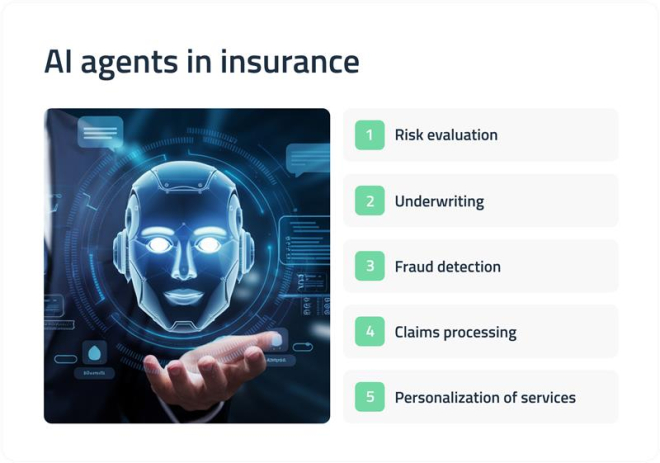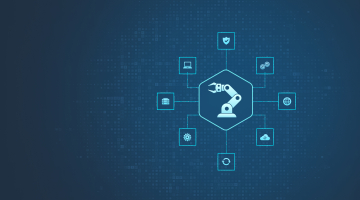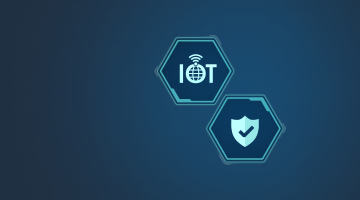

AI agents for the insurance industry: Components and implementation
The insurance business has always been one of the most traditional domains, resisting changes and relying on tried-and-tested approaches and methods in its pipeline operations. Yet, even the most conservative insurance professionals can’t ignore the achievements of Industry 4.0, which is making a robust entrance into multiple verticals. Suppose they want to meet their clients halfway and satisfy all customer expectations regarding fast and efficient service. In that case, insurance companies have no choice but to utilize cutting-edge technologies in their workflows.
Artificial intelligence (AI) and related know-how (such as machine learning, natural language processing, generative AI, computer vision, and more) were the most widespread breakthrough innovations disrupting the insurance sector in the early third millennium. Current market trends expose a steep rise in insurtech product employment, which will increase more than 17 times within ten years, displaying a breathtaking CAGR of 33+% and exceeding the mind-blowing value of $141 billion!
Among many AI-powered tools that have inundated the contemporary insurance landscape, AI agents are rightly considered the most effective in reinventing how insurance companies’ employees perform their responsibilities and handle brand-customer interactions.
This article will unlock the essence of AI insurance agents, explore their roles and types, disclose their benefits for the insurance process and its stakeholders, and list their use cases. It is also a manual for building insurtech AI tools based on large language models.
Discover our chatbot for the insurance industry
AI insurance agents explained
Today, when we use the term “insurance agent,” it can denote not only human employees who work in the company and handle pipeline operations, guiding their clients from A to Z in their home, health, or auto insurance routine. AI technology has given new meanings to familiar words, and the same is true about this one. Human agents of the past are being increasingly ousted by AI agents – software products that work autonomously and perform small-scope and strategic decision-making based on input data, pre-defined goals, and current operational conditions. How are they different from the conventional automation systems many insurance organizations rely on in their workflows?
Old-school tools function according to algorithms outlined in instructions, making them relatively rigid and change-resistant. AI-driven programs are independent agents, meaning they think and act independently. Moreover, such solutions can continuously improve and adapt, assess their surroundings, understand context, learn from new interactions, and choose the most optimal course to attain specific objectives.
What are the essential characteristics of AI agents?
- Perception. AI agents register changes in their environment – from market fluctuations to customer preferences dynamics.
- Responding. Having noticed these changes, AI agents take actions that impact the environment (like adjusting merchandise pricing on an e-commerce site).
- Interpretation and reasoning. AI agents sift through complex datasets, recognize patterns, derive valuable insights, and participate in making informed decisions.
- Problem-solving. AI agents’ decisions are instrumental in addressing various shop floor challenges (e.g., supply chain optimization, identifying technical malfunctions, devising marketing strategies, etc.).
- Learning and inference. AI agents analyze data (both historical and real-time) to forecast future developments, and the precision of this predictive modeling grows with every new data entry processing.
- Outcome analysis. Advanced data analytics capabilities allow AI agents to consider various scenarios and their impact on an organization’s potential steps in its routine operations.
All these features are symptomatic of any AI agents that come in various guises.
Experiencing a lack of AI expertise?
Connect with a professional team to address your project challenges.
Types of AI agents
AI agents are classified into several categories based on their unique functionalities, underlying operational principles, and applications.
- Simple reflex agents are based on the condition-action model and react to sensory input. Since such agents don’t form an internal representation of the environment they work in, they are ideal for surroundings where actions are conditioned exclusively by the current situation. Their inability to reason and predict consequences from past experiences makes them inadequate for dealing with complex queries or unstructured environments.
- Model-based reflex agents. Unlike the previous variety, these agents create an internal representation of the environment, enabling them to reconstruct the surroundings’ only partially observable elements. As a result, the actions they suggest are based on both current perception and prior knowledge reflected in inferred components of the environment that supply the missing information.
- Goal-based agents. They compare the actions to be taken with each other and figure out which of them is more likely to achieve the goal set for them. This ability conditions their employment for complex decision-making assignments.
- Utility-based agents. As the name suggests, these tools rely on a utility function that assigns various numerical values to different states in accordance with their relative preference. Then, the agent selects the state with the greatest index and prioritizes it to achieve the desirable outcome. Leveraging AI agents of this type is recommended in scenarios with multiple potential outcomes that can be represented in clearly comprehensible metrics.
- Learning agents. In fact, any of the agents mentioned above can be learning ones if they can improve their performance by learning from experience. It is highly instrumental in working with dynamic environments where the situation evolves in real-time, so agents can fine-tune their approaches and optimize the outcome.
- Multi-Agent Systems (MAS). Here, several agents work in harmony, joining their efforts in solving complex tasks that require meticulous coordination (for instance, supply chain management, where each agent represents an individual element of the supply chain).
- Hierarchical agents. It is easy to guess that these agents form a hierarchical structure where higher-level ones direct lower-level agents. Such tools are practical for operating large-scale systems that require management on several levels, where each level agent is assigned specific responsibilities and roles, thus contributing to the common cause.
These agents – from basic ones performing standalone tasks to complex ecosystems managing sophisticated processes – can be applied in the insurance industry.
AI agents in insurance
As essential components of modern AI-fueled professional IT infrastructure, insurance AI agents are honed to facilitate and streamline operations that constitute the backbone of the regular insurance pipeline, dramatically improving operational efficiency. They emulate human cognitive functions but perform them at a higher level since they can process far greater volumes of data much more quickly, free from human errors and biases.

Let’s see where insurtech AI agents can bring maximum value.
- Risk evaluation. AI agents excel at analyzing vast amounts of relevant information (past claims data, customer profiles, market trends, etc.) to anticipate possible risks and establish optimal premiums. Such risk assessments based on predictive models guarantee accurate and fair pricing and satisfied customers.
- Underwriting. AI agents conduct in-depth customer data analysis to determine risks related to insuring organizations or individuals, promoting underwriting processes immensely, and cutting down on the time needed for them.
- Fraud detection. When they perceive anomalies in transactions and claims, AI agents red-flag those bearing the signs of fraudulent activities. Their advanced algorithms honed to detect fraudulent claims get ever more sophisticated as the software learns about new fraud tactics, which strengthens the integrity and security of the insurance routine.
- Claims processing. AI agents can automate data collection, verification, preliminary assessment, and other stages of this basic insurance workflow. They minimize errors and ensure a quick response time to customer inquiries.
- Personalization of services. For AI agents, customer-related records become the source of data-driven insights, helping companies perform customer segmentation and understand the needs and preferences of each client. It allows insurance organizations to offer them personalized insurance products, thus boosting customer retention and loyalty.
To function seamlessly in carrying out these tasks, AI insurance agents should rely on a proper organizational structure.
Modules of AI agents for insurance
A typical AI agent leveraged by insurance companies has three basic modules in its architecture.
The input module
This component captures textual, auditory, and visual inputs from various sources (primarily from users but also from other relevant channels and agents). Speaking of insurance, information derived from multiple quarters includes policy documents, regulatory standards for the industry, medical records, customer queries, claims forms, etc.
The processing module
This is the agent’s brain responsible for its cognitive operations (reasoning, decision-making, planning, and the like). It consists of several components.
- The profiling submodule. It specifies the agent’s function (for instance, risk management, underwriting, claims processing, customer support, etc.) and establishes its purpose for specific tasks.
- The memory submodule accumulates and stores all agent data and interactions, enabling it to learn from past experience. Thanks to it, the tool can track and analyze customer history, policy changes, and other data dynamics.
- The knowledge submodule. It also hoards records and dossiers but of a different kind. Here belong legal regulations, policy details, fraud detection guidelines, risk assessment criteria, and other niche information utilized in decision-making.
- The planning submodule outlines the appropriate sequence of actions depending on the stipulated task requirements. This feature is typically employed for policy recommendations or claims adjudications, and it is highly efficient in handling customer inquiries.
The execution module
It leverages relevant tools from the toolkit it is equipped with to implement outlined plans in accordance with contextual requirements. To do that, a complex task is split into a series of manageable steps, each performed by employing a certain tool. For example, the execution module can automate repetitive tasks like claims processing following the pre-defined algorithm, where the agent verifies submitted documents, evaluates damage reports, and calculates payouts, keeping track of regulatory compliance throughout the entire procedure.
This multi-layered architecture guarantees the seamless functioning of AI agents and ushers in numerous boons for insurance organizations that leverage them in their workflows.
The benefits of AI agents in insurance showcased
Insurance companies that employ AI agents as vital elements of their IT infrastructure report the following upsides of using them.
- Increased efficiency. By automating repetitive jobs (like data entry, document processing, or tackling basic customer support tasks), AI agents free the human workforce to handle more creative or complex errands, thus enhancing the organization’s efficiency and facilitating many shopfloor processes, including claims management, underwriting, and more.
- Improved risk assessment. Analyzing vast amounts of relevant data (both structured and unstructured) is a cakewalk for AI agents that can spot patterns and factors escaping the attention of human analysts. Having the analysis results on the table; employees can forestall risks, accurately determine premium pricing, and minimize underwriting errors.
- Data-driven decision-making. AI agents perform a comprehensive analysis of information retrieved from multiple sources, enabling stakeholders to obtain actionable insights and recommendations they can utilize in strategic decision-making. Depending on the specifics of the analyzed data, such decisions can refer to any insurance workflow, from product development and claims management to market segmentation and customer acquisition.
- Boosted fraud prevention. AI agents’ advanced algorithms allow them to identify suspicious activities in real-time, which is beneficial for mitigating risk and minimizing financial losses.
- Predictive analytics. AI agents’ predictive power can also be applied to forecast future trends. With these insights, insurers can adjust their strategies, pricing approaches, and policy coverage, thus optimizing business outcomes.
- Cost reduction. When an insurance agency minimizes fraud, envisages risks, and automates routine processes, it cuts down on operational costs. As conversational AI-powered virtual assistants handle customer support, the need for human personnel diminishes, which is also a significant cost-saving factor.
- Regulatory compliance. AI agents ensure that legal guidelines and requirements are consistently applied across all workflows. Moreover, they maintain transparent audit trails and track regulatory changes, helping insurance organizations avoid hefty non-compliance fines and other disciplinary consequences.
- Scalability. As your organization expands and taps new markets, AI agents can be easily upscaled to handle increased volumes of data and more transactions without involving additional human resources.
- Augmented personalization of customer experiences. The scrupulous analysis of individual customer data allows AI agents to offer highly tailored product recommendations and pricing to each client. Such a targeted approach improves the efficiency of upselling and cross-selling initiatives, increases customer satisfaction, and fosters brand loyalty.
When combined, all these assets pave the way for a more efficient, client-focused, and lucrative insurance industry, making AI investments worthwhile. Let’s see how AI agents find practical applications in the insurance pipeline.
Insurance AI agents’ use cases
The insurance domain relies on several basic workflows where AI agents can become game-changers.
Customer verification and onboarding
AI mechanisms conduct fast and accurate biometric analysis and document verification to establish a customer’s identity and minimize the risk of creating fake accounts. Also, AI agents driving chatbots can guide clients through the onboarding process, ensuring a smooth experience and making a positive first impression of interacting with the brand.
Claims handling and administration
AI agents facilitate and streamline claims processing in multiple ways. First, they automate claims assessment by quickly analyzing and verifying their legitimacy by involving and cross-referencing relevant data from accident reports, medical records, policy details, and more. Second, they watch for anomalies and patterns in past claims data to rule out fraud attempts. Their ML-powered algorithms improve their fraud detection capabilities with each new case and increase accuracy in pinpointing such instances.
As a result, the entire claims processing routine is essentially automated, leading to faster adjudications, settlements, and disbursements. In contrast, fraud occurrences are kept to a minimum, saving insurance companies millions.
Underwriting and risk analysis
AI agents conduct enhanced risk profiling by analyzing customer-related data, including the credit score, lifestyle factors, and even social media activity. Having obtained a 360-degree view of potential clients, they can adjust premium pricing, considering all possible risk factors. Such risk profiles allow for modifying current policies and augment insurers’ predictive power. AI agents forecast claim severity and frequency, which improves risk portfolio management.
Customer support and interaction
The robust advent of AI-driven chatbots and virtual assistants in customer service marks the transition to more effective inquiry handling and round-the-clock support. AI agents provide instant and accurate responses to customer queries, thus boosting customer satisfaction. Besides, by analyzing client feedback and interactions, they can offer personalized recommendations and tailored advice concerning various aspects of the insurance pipeline.
Marketing and sales strategies
Customer data analysis conducted by AI agents has one more implication. Innovative tools can perform lead scoring by examining demographic information, online behavior, engagement history, and other factors. It allows them to prioritize leads and target the most valuable ones with tailored marketing campaigns that resonate with each promising prospect.
Policy administration
AI agents automate sending policy renewal reminders, data entry, document generation, and other routine procedures the insurance pipeline abounds in. Such automation initiatives minimize red tape, reduce administrative workload, and accelerate policy handling workflow.
Risk management and prevention
AI agents can predict not only market trends and customer behavior but also potential failures of an insurance company’s hardware and machinery. Leveraging equipment sensor data, AI solutions can forecast repair needs and recommend preventive maintenance to forestall breakdowns that incur costly fixing or replacement.
Claims prioritization
Some claims (especially those related to health insurance) require urgent attention, quick adjudication, prompt responses, and fast disbursement. AI agents can pinpoint and prioritize such claims, alerting insurers to direct all their efforts to handle them immediately.
Omnichannel customer engagement
Today, people use multiple communication channels to interact with insurance companies and apply for their services. AI agents seamlessly integrate mobile apps, websites, emails, phones, and social media into a cohesive ecosystem that enables consistent interaction with potential and current policyholders across these platforms. This ramified insurance environment enhances customer engagement and streamlines access to relevant services.
Document and data management
The insurance sector has always been a red tape-ridden domain with many documents to fill out, process, and store. AI agents can dramatically improve the extraction and handling of information from claims forms, medical records, policy applications, customer messages, etc. They do it quickly and accurately, avoiding errors and boosting the efficiency of text analysis. Besides, they can perform advanced analyses of these documents’ data, discover trends, and unlock valuable insights to be leveraged in further decision-making.
You can maximize the value of these perks by creating bespoke AI agents based on large language models (LLMs).
Estimate project costs
Please share more details of your project with our team.

Developing LLM-based AI agents for insurance: A roadmap to follow
While crafting LLM-driven AI solutions, we at DICEUS adhere to a well-thought-out plan containing 15 steps.
Step 1. Defining scope and objectives
We start by establishing insurance tasks (claims processing, underwriting, risk assessment, customer support, etc.) that the future solution will handle and the challenges it will address while performing them.
Step 2. Choosing an appropriate model and platform
The selection of an LLM is conditioned by several factors, such as model size, performance, and licensing (open-source or commercial). Besides, we make sure to choose the model relevant for performing special shop floor tasks. For instance, LLaMA by Meta is honed for fraud detection and policy analysis, GPT family by OpenAI is utilized for customer interactions and natural language understanding, PaLM by Google is the best for decision support in underwriting, etc.
As for AI agent-building platforms, we typically rely on Microsoft’s AutoGen, which provides a complete set of diverse tools for developing software capable of dealing with multi-turn conversations. For novices in the field, we recommend the no-code CrewAI platform, whose intuitive interface streamlines defining agent workflows and efficiently managing their interactions.
Step 3. Data collection and curation
At this stage, we assemble relevant data from all available sources (both an organization’s internal ecosystem and external platforms). Then comes data preparation, which includes ensuring its completeness, accuracy, consistency, integrity, conformity, and compatibility with the LLM we are going to build.
Step 4. Model training
After all necessary data is prepared, the LLM is trained on task-specific datasets to empower it for solving envisaged assignments. While doing it, we experiment with phrasing questions and prompts to obtain the most accurate responses from the model.
Step 5. Designing an AI agent’s architecture
We develop all modules pertinent to solving insurance tasks (input, processing, and execution), providing seamless connections between them.
Step 6. Augmenting comprehension capabilities
This is implemented by using advanced natural language understanding mechanisms. They enable the AI agent to accurately interpret and parse complex commands and responses, discern user intent, summarize topics, and generate effective outcomes. Besides, we make sure the AI agent can identify and retrieve specific insurance terms and entities from unstructured textual data to perform comprehensive analysis and provide decision-making support.
Step 7. Involving data from external sources
We integrate the AI agent with multiple external platforms and databases to augment its access to various insurance-related records and dossiers. To guarantee the accuracy and reliability of subsequent analysis, it is vital to provide robust data validation and cross-reference mechanisms. Also, we make sure AI agents’ machine learning capabilities enable them to learn from new data points and update their knowledge base from the latest industry trends, research results, and evolving datasets.
Step 8. Boosting reasoning and analytical capabilities
At this stage, we implement high-end algorithms for in-depth data analysis (that include pattern recognition, trend identification, and statistical analysis), develop hypothesis-generating features, and create capabilities for logical reasoning, discerning correlations, understanding context, and deriving conclusions. All these characteristics are mission-critical for enhancing the decision-making power of the future solution.
Step 9. Designing output generation
We engineer AI agent’s capability to produce summaries and reports that streamline data analysis. Besides, users will be able to leverage the output produced by the AI agent more efficiently if it is arranged in the form of compelling graphs, charts, dashboards, diagrams, and other visualizations. They illustrate patterns and trends and improve data comprehension.
Step 10. Taking care of ethical considerations
Typical ethical concerns related to utilizing AI-based products include the accountability and transparency of their operation, the safety of data they use for model training, and the absence of bias. Our experts consistently address these concerns and ensure the agent’s ethical usage.
Step 11. Creating UI
The solution’s interface should be intuitive and uncluttered, providing no-sweat interaction and ensuring accessibility for the workforce with different expertise levels. Moreover, it should foster collaboration between human personnel and AI agents, enhancing the unified power of the combined effort.
Step 12. Testing and validation
Next, the newly built system is tested extensively across multiple usage scenarios and insurance tasks. The AI agent’s output is also validated against various benchmarks to ensure its reliability and operation accuracy.
Step 13. Deployment and scaling
First, we determine what infrastructure parameters (storage capacity, computational resources, security protocols) are required for the AI agent’s deployment and envisage possible scalability measures. Then, we put the solution into operation.
Step 14. Continuous updating and improvement
We exercise post-deployment monitoring of the AI agent’s functioning, introduce regular updates, conduct version control, and establish feedback loops that help us identify problems and react to issues promptly.
Step 15. Documentation and training
As a responsible vendor, we produce all relevant documentation about the AI agent’s architecture and operation. A special set of documents covers workforce training and the best practices for integrating AI into the insurance pipeline and handling AI-powered insurance solutions.
Creating a high-quality LLM-based insurtech AI agent is a no-nonsense ordeal that can hardly be tackled by insurance companies alone and unaided. To obtain a first-rate solution that will meet your expectations, we recommend hiring seasoned professionals with a proven track record.
How DICEUS can assist in building AI agents for insurance
Creating a top-notch AI agent for insurance is attainable if the IT vendor satisfies two conditions. First of all, the outsourcing company should be competent in AI technology. Second of all, it should possess experience in delivering projects for the insurance industry.
DICEUS ticks all these boxes. Our qualified and certified experts are well-versed in artificial intelligence, machine learning, large language models, natural language processing, and other AI-related domains. Plus, they have a long history of cooperating with insurance firms, so they know this realm inside out. Consequently, we can tackle the creation of a custom AI agent for an insurance organization that will perform all assigned tasks and drive the company’s digital transformation.
If you don’t have time to wait until bespoke software is crafted, we have a ready-made insurance product line that can be deployed on short notice. Our Vitaminise collection includes a range of AI-fueled products (a mobile app, a web portal, a chatbot, a data analytics solution, and a customer feedback tool) that can be harnessed in complex or as standalone products. They are compatible and can be fine-tuned to dovetail with your technical and business requirements. By acquiring Vitaminise solutions, you will reinvent the lion’s share of your insurance workflows and get a sharp competitive edge over your less digitally savvy rivals.
Contact us to boost your shop floor routine with the power of artificial intelligence.
Key takeaways
AI agents are high-end solutions that work autonomously and emulate the operation of the human mind (perception, responding, reasoning, interpretation, problem-solving, analysis, and more). They are capable of continuous improvement and assessing their environment. Their architecture consists of three basic modules (input, processing, and execution), the operational principle, and the application sphere, which allows them to be categorized into several types.
When applied in the insurance sector, these tools can facilitate and streamline numerous shop-floor activities, including claims processing, risk assessment, underwriting, fraud detection, customer support, policy management, and more. Insurance companies can use them to increase their efficiency, automate repetitive tasks, analyze vast amounts of customer and business data, predict future trends, monitor regulatory compliance, make data-driven decisions, reduce OPEX, and personalize their products and services.
Insurtech AI agents bring maximum value if designed according to a 15-step roadmap to meet your organization’s unique business and technical requirements. If you lack expertise in doing it, you should delegate the task to vetted IT professionals who will create a bespoke product or offer a ready-made AI agent with significant adaptability potential.
Frequently asked questions
What are the different types of AI agents used in the insurance industry?
Insurance companies can leverage simple reflex agents, model-based reflex agents, goal-based agents, utility-based agents, hierarchical agents, or multi-agent systems, all of which can be equipped with learning capabilities. The choice of an AI agent is conditioned by its specific insurance use cases and the complexity of tasks it is called to solve.
How do AI agents enhance claims processing and management in insurance?
Insurance case data collection, verification, policy reviewing, damage assessment, and payment disbursement take quite a time. AI agents can accelerate this process without compromising the accuracy of analysis, ruling out errors and other human factors that can adversely influence the speed and quality of services.
What are the benefits of using AI agents for underwriting and risk assessment in insurance?
Thanks to AI data processing capabilities, these insurtech solutions can sift through vast amounts of customer-related information from external and internal sources and create detailed client risk profiles. Such dossiers are used as guidelines in employees’ decisions to insure the person or not. Also, these profiles serve as the basis for adjusting premium prices and thus optimizing expenditures.
How can AI agents improve insurance companies’ customer service and engagement?
AI-powered virtual assistants and chatbots are the staples of customer service across various verticals, and the insurance sector is no exception. These AI agents automate the handling of simple queries, thus freeing the human workforce to deal with more complex issues. Besides, AI agents can analyze client feedback and preferences to offer personalized recommendations and tailored products, boosting customer satisfaction and brand loyalty.
How can DICEUS help in developing AI agents for insurance?
Competent in crafting insurance solutions and developing AI-driven products, we can create a bespoke AI agent that will fit your company’s technical and business requirements. Or, you can acquire our ready-made Vitaminise kit (containing a mobile app, a web portal, a chatbot, a data analytics solution, and a customer feedback tool) in block or as standalone products to push the technological envelope of your insurance organization and revolutionize its workflows.





